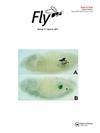吞噬基因对果蝇非凋亡护理细胞死亡的控制
IF 2.4
4区 生物学
Q3 BIOCHEMISTRY & MOLECULAR BIOLOGY
引用次数: 16
摘要
程序性细胞死亡是果蝇卵母细胞发育的正常组成部分。对于每一个形成的卵子,15个种系衍生的保育细胞将其细胞质内容物转移到卵母细胞中并死亡。细胞凋亡或自噬的破坏仅部分抑制护士细胞的死亡,这表明其他机制对护士细胞死亡有显著影响。最近,我们证明,在卵子发生后期,周围的拉伸卵泡细胞非自主地促进护士细胞死亡,吞噬基因,包括draper、ced-12和JNK通路,对这一过程至关重要。当卵泡细胞中的吞噬基因被抑制时,与护士细胞死亡特异性相关的事件就会受损。在窗帘突变体中,护士细胞的死亡并没有被完全阻断,这表明其他吞噬受体也参与其中。事实上,我们发现整合素亚基,αPS3,在卵子发生后期在拉伸卵泡细胞上富集,是清除哺乳细胞所必需的。此外,双突变体分析显示整合素与窗帘蛋白平行作用。果蝇卵巢中护士细胞的死亡是程序性细胞死亡的一个独特例子,它既是非细胞凋亡的,也是非细胞自主控制的。本文章由计算机程序翻译,如有差异,请以英文原文为准。
Control of non-apoptotic nurse cell death by engulfment genes in Drosophila
ABSTRACT Programmed cell death occurs as a normal part of oocyte development in Drosophila. For each egg that is formed, 15 germline-derived nurse cells transfer their cytoplasmic contents into the oocyte and die. Disruption of apoptosis or autophagy only partially inhibits the death of the nurse cells, indicating that other mechanisms significantly contribute to nurse cell death. Recently, we demonstrated that the surrounding stretch follicle cells non-autonomously promote nurse cell death during late oogenesis and that phagocytosis genes including draper, ced-12, and the JNK pathway are crucial for this process. When phagocytosis genes are inhibited in the follicle cells, events specifically associated with death of the nurse cells are impaired. Death of the nurse cells is not completely blocked in draper mutants, suggesting that other engulfment receptors are involved. Indeed, we found that the integrin subunit, αPS3, is enriched on stretch follicle cells during late oogenesis and is required for elimination of the nurse cells. Moreover, double mutant analysis revealed that integrins act in parallel to draper. Death of nurse cells in the Drosophila ovary is a unique example of programmed cell death that is both non-apoptotic and non-cell autonomously controlled.
求助全文
通过发布文献求助,成功后即可免费获取论文全文。
去求助
来源期刊

Fly
生物-生化与分子生物学
CiteScore
2.90
自引率
0.00%
发文量
17
审稿时长
>12 weeks
期刊介绍:
Fly is the first international peer-reviewed journal to focus on Drosophila research. Fly covers a broad range of biological sub-disciplines, ranging from developmental biology and organogenesis to sensory neurobiology, circadian rhythm and learning and memory, to sex determination, evolutionary biology and speciation. We strive to become the “to go” resource for every researcher working with Drosophila by providing a forum where the specific interests of the Drosophila community can be discussed. With the advance of molecular technologies that enable researchers to manipulate genes and their functions in many other organisms, Fly is now also publishing papers that use other insect model systems used to investigate important biological questions.
Fly offers a variety of papers, including Original Research Articles, Methods and Technical Advances, Brief Communications, Reviews and Meeting Reports. In addition, Fly also features two unconventional types of contributions, Counterpoints and Extra View articles. Counterpoints are opinion pieces that critically discuss controversial papers questioning current paradigms, whether justified or not. Extra View articles, which generally are solicited by Fly editors, provide authors of important forthcoming papers published elsewhere an opportunity to expand on their original findings and discuss the broader impact of their discovery. Extra View authors are strongly encouraged to complement their published observations with additional data not included in the original paper or acquired subsequently.
 求助内容:
求助内容: 应助结果提醒方式:
应助结果提醒方式:


